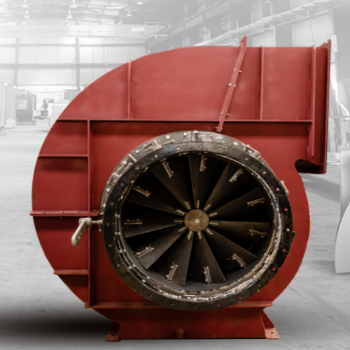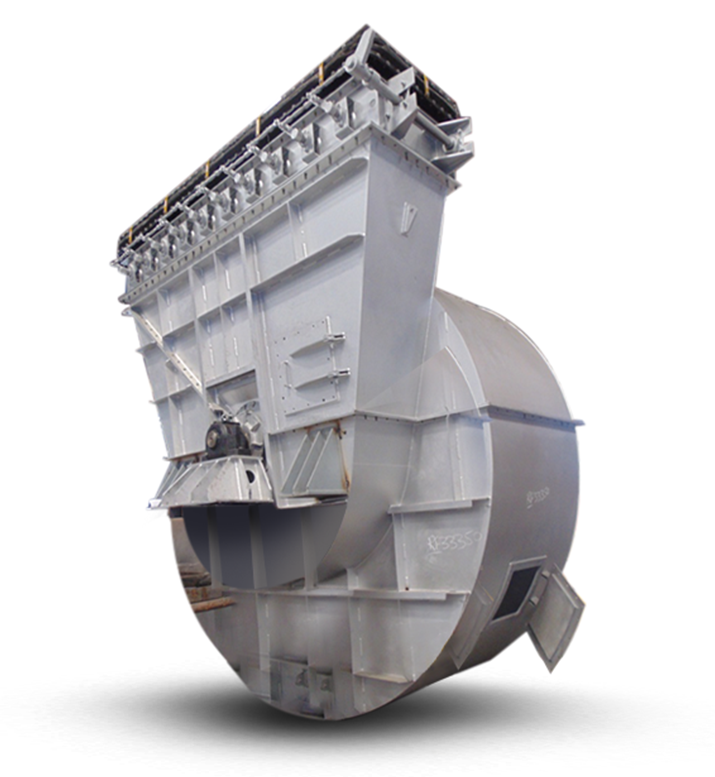Draught Fans Used in Thermal Power Plants
Draught fans play an important role in thermal power plants by providing critical support to the various process activities related to power generation. Coal-fired thermal power plants systems use several types of process fans. Based on the size of the boiler or steamer the rating of the fan used differs and based on the type of air flow and the process involved different types of draught fans are used in thermal power plants. An attempt is being made to explain the types of draught fans used in thermal power plants in an easy to understand format in this article.
Draught Fans and Their Usage in Thermal Power Plants Draught fans are a type of industrial process fans and are broadly divided into two types – Forced Draft (FD Fan) and Induced Draft (ID Fan). The primary difference between a forced draft and induced draft is, FD fan forces outside air into the heating system whereas ID fan draws flue gases from the system out into the atmosphere. Both FD fan & ID fan operate in such a way that it balances the air system in the thermal plant to make the combustion process efficient. Further details of the FD and ID Fans are provided to the end of this article.
Draught fans are a type of industrial process fans and are broadly divided into two types – Forced Draft (FD Fan) and Induced Draft (ID Fan). The primary difference between a forced draft and induced draft is, FD fan forces outside air into the heating system whereas ID fan draws flue gases from the system out into the atmosphere. Both FD fan & ID fan operate in such a way that it balances the air system in the thermal plant to make the combustion process efficient. Further details of the FD and ID Fans are provided to the end of this article.
Draught fans are extensively used in thermal power plants for performing the various process activities like supplying the pulverized coal and air mixture for combustion, regulating the combustion, super heating the steam, preheating the air, sending the flue gases into the combustion chamber to reduce pollutants or drawing out the flue gases from combustion chamber to the chimney.
Primary Air Fans or PA Fans
A key component of the thermal power generation plant is the boiler, which is also called as steam generator. The essence of the thermal power generation plant is to create the steam in boilers or steamers, this steam is send at high pressure to a stationary turbine that generates electricity. The coal is first crushed into minute particles using equipment called pulverizers. The main function of the Primary air fan or PA fan is to carry the pulverized coal to the furnace as fuel for combustion. This process is used to create the steam that is the primary process in the thermal power plant. In power plants, the PA fans supply air for conveying of the pulverized coal from coal mills to the furnace area. These primary air fans produce a high pressure to push the coal and air mixture through pulverizer into the furnace. The most common configuration of the draught fans used as a PA fan is the backward curved centrifugal fan. In power plants the PA fans play an important role in supplying air necessary for fuel combustion and in the maintenance of furnace temperature.
Secondary Fans or SA Fans The secondary fans (SA fans) play an important supporting role in power plants. The secondary fan allows for complete combustion of the fuel inside the furnace. As and when required the SA fan is used to increase the air flow to improve the efficiency and avoid wastage of fuel. Coal based thermal plants share of electricity generation is highest compared to other methods like hydroelectric, wind, gas or solar based plants. Further, this can be run continuously. Coal is mined at one location and then sufficient water and land is required for the power plant. Considering the cost of transport and high costs of coal mining, it would not be right to do inefficient burning of the coal in the furnace. Considering all these facts, secondary fans play a key role is maintaining the efficiency of the thermal power plant is very
The secondary fans (SA fans) play an important supporting role in power plants. The secondary fan allows for complete combustion of the fuel inside the furnace. As and when required the SA fan is used to increase the air flow to improve the efficiency and avoid wastage of fuel. Coal based thermal plants share of electricity generation is highest compared to other methods like hydroelectric, wind, gas or solar based plants. Further, this can be run continuously. Coal is mined at one location and then sufficient water and land is required for the power plant. Considering the cost of transport and high costs of coal mining, it would not be right to do inefficient burning of the coal in the furnace. Considering all these facts, secondary fans play a key role is maintaining the efficiency of the thermal power plant is very
Flue Gas Recirculation Fans
Gas recirculation fans (FGR) are typically used in power plant boilers to reduce the flue gas pollution content in the gases exhausted from thermal combustion processes. Flue gas re-circulation is a highly effective technique that significantly reduces the Nitrogen oxide (NOx) emissions from burners. Controlling NOx is critical as it the largest contributor to other types of harmful pollutants. NOx emissions are mostly derived from the nitrogen in the combustion air (thermal NOx). These pollutants are produced during combustion process when nitrogen and oxygen react at elevated temperatures. NOx emission levels can be greatly reduced in industrial boilers by recirculating the flue gases from the boiler exhaust duct into the main combustion chamber. The most common types of gas re-circulation fans are backward curved centrifugal fans.
Forced Draft and Induced Draft Fans There are other process fans used in the various sub-processes in the power plant which are also draught fans. Further, as mentioned earlier the difference between the forced draft and induced draft fans is outlined here. Draught fans whether they are FD fans or ID fans are typically centrifugal fans. Forced draught fan is commonly referred as forced draft fan and induced draught fan as induced draft fan. Centrifugal fans are also called as radial fans and sometimes as centrifugal blowers.
There are other process fans used in the various sub-processes in the power plant which are also draught fans. Further, as mentioned earlier the difference between the forced draft and induced draft fans is outlined here. Draught fans whether they are FD fans or ID fans are typically centrifugal fans. Forced draught fan is commonly referred as forced draft fan and induced draught fan as induced draft fan. Centrifugal fans are also called as radial fans and sometimes as centrifugal blowers.
Forced Draft Fan
An FD fan draws air from the atmosphere and forces it into the furnace through a preheater. These fans are located at the inlet of the boiler to push high pressure fresh air into combustion chamber, where it mixes with the fuel to produce positive pressure. The most common centrifugal fans used as FD fans are backward curved and airfoil centrifugal fans. In power plants, where coal is used as fuel for combustion, FD fans are used as primary and secondary air fans to regulate proper combustion and maximize the fuel efficiency of the process.
A typical FD fan arrangement uses inlet and outlet dampers to control and maintain the required air pressure inside the system. These fans have a wheel at the center that is hung on the shaft along with inlet boxes, silencer, filter and rain hood. When compared to ID fans, FD fans are easier to maintain and have cleaner operating conditions.
Induced Draft Fan
Induced draft fan is normally located at the outlet between dust collector and chimney. The fan takes hot flue gases from the boiler through dust collector and delivers it to the chimney into the open atmosphere. ID fan creates negative pressure or suction to discharge the gases out after combustion from the furnace. Since ID fans can handle hot flue gases, they have more corrosion and erosion problems even when used with Electrostatic precipitators. The most common type of fans used as ID fans are the backward inclined blade centrifugal fans.
Draught Fans Play a Vital Role in Thermal Power Plant Operations
Draught fans of various types and ratings are used as process fans in power plants. Draught fans are typically heavy duty centrifugal fans. Draught fans are an essential and irreplaceable component of a thermal power plant.
